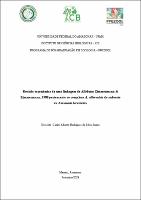| ???jsp.display-item.social.title??? |


|
Please use this identifier to cite or link to this item:
https://tede.ufam.edu.br/handle/tede/11324| ???metadata.dc.type???: | Dissertação |
| Title: | Revisão taxonômica de uma linhagem de Allobates Zimmermann & Zimmermann, 1988 pertencente ao complexo A. albiventris do sudoeste da Amazônia brasileira |
| Other Titles: | Taxonomic revision of a lineage of Allobates Zimmermann & Zimmermann, 1988 belonging to the A. albiventris species complex from southwestern Brazilian Amazonia |
| ???metadata.dc.creator???: | Silva Junior, Carlos Alberto Rodrigues da  |
| ???metadata.dc.contributor.advisor1???: | Silva Junior, Miquéias Ferrão da |
| First advisor-co: | Lima, Albertina Pimentel |
| ???metadata.dc.contributor.referee2???: | Ferreira, Anthony Santana |
| ???metadata.dc.contributor.referee3???: | Almeida, Alexandre Pinheiro de |
| ???metadata.dc.description.resumo???: | A rãzinha enfermeira Allobates albiventris foi descrita recentemente e habita florestas de terras baixas no sudoeste da Amazônia brasileira. Estudos filogenéticos recentes indicaram que esta espécie representa na verdade um complexo de espécies com várias linhagens não nomeadas associadas a espécie nominal na Amazônia central e sudoeste do Brasil, e provavelmente na Bolívia e no Peru. Taxonomia integrativa foi usada no presente estudo para revisar uma dessas linhagens na Bacia do médio rio Juruá, no Brasil. Nossa inferência filogenética multilocus recuperou a nova espécie na posição mais basal dentro do clado que representa o complexo de espécies A. albiventris. A nova espécie difere da maioria de suas congêneres por ter um chamado composto por um par de notas emitidas em uma única exalação, tal padrão de chamado é relatado dentro do clado A. caeruleodactylus apenas para A. albiventris. O canto de anúncio da nova espécie é caracterizado por ter duração de 50 ± 3 ms (43–56 ms), a primeira nota (13 ± 3 ms) mais curta que a segunda (19 ± 3 ms), onde a primeira nota tem uma frequência dominante de 5.215 ± 138 Hz (4.907–5.440 Hz) e a segunda nota 5.541 ± 160 Hz (5.290–5.825 Hz). Os adultos têm dorso tuberculado a granulado, SVL de 16,4 ± 0,57 mm nos machos e 17,3 ± 0,4 mm nas fêmeas, dedos II e III inchados nos machos, e saco vocal branco sem melanóforos. Os girinos têm de duas a quatro papilas curtas e arredondadas distribuídas em uma única fileira em cada margem lateral do lábio anterior; comprimento relativo das fileiras de dentes P2>P1>P3 (P1 = 0,93 ± 0,10 mm; P2 = 0,91 ± 0,06 mm; e P3 = 0,90 ± 0,15 mm). |
| Abstract: | The nurse frog Allobates albiventris was recently described and inhabits lowland forests in Brazilian southwestern Amazonia. Recent phylogenetic studies have indicated that this species indeed represent a species complex with several unnamed lineages associated with it across southwestern and central Amazonia in Brazil and probably in Bolivia and Peru. Integrative taxonomy was used in the present study to revise one of these lineages from middle Juruá Basin in Brazil. Our multilocus phylogenetic inference recovered the new species in the most basal position within the clade representing the A. albiventris species complex. The new species differs from most congeners by having a call composed of a pair of notes emitted in a single exhalation, such call pattern is a reported within the A. caeruleodactylus clade only for A. albiventris. The advertisement call of the new species is characterized by a call duration of 50 ± 3 ms (43–56 ms), first note (13 ± 3 ms) shorter than the second (19 ± 3 ms); the first note has a dominant frequency of 5,215 ± 138 Hz (4,907–5,440 Hz) and the second note 5,541 ± 160 Hz (5,290–5,825 Hz). Adults have a tuberculate to granulate dorsum, SVL 16.4 ± 0.57 mm in males and 17.3 ± 0.4 mm in females, fingers II and III swollen in males, a white vocal sac without melanophores. Tadpoles have two to four short, rounded papillae distributed in a single row on each lateral margin of the anterior lip; relative length of the tooth rows P2>P1>P3 (P1 = 0.93 ± 0.10 mm; P2 = 0.91 ± 0.06 mm; and P3 = 0.90 ± 0.15 mm). |
| Keywords: | Anuros - Pesquisa Biodiversidade - Conservação - Amazônia Morfologia (Animais) - Amazônia |
| ???metadata.dc.subject.cnpq???: | CIENCIAS BIOLOGICAS |
| ???metadata.dc.subject.user???: | Anura Amazonian biodiversity Biodiversidade amazônica Aromobatidae Taxonomia integrativa Rio Juruá Rãzinhas cuidadoras Aromobatidae Integrative taxonomy Juruá River Nurse frogs |
| Language: | por |
| ???metadata.dc.publisher.country???: | Brasil |
| Publisher: | Universidade Federal do Amazonas |
| ???metadata.dc.publisher.initials???: | UFAM |
| ???metadata.dc.publisher.department???: | Instituto de Ciências Biológicas |
| ???metadata.dc.publisher.program???: | Programa de Pós-graduação em Zoologia |
| Citation: | SILVA JUNIOR, Carlos Alberto Rodrigues da. Revisão taxonômica de uma linhagem de Allobates Zimmermann & Zimmermann, 1988 pertencente ao complexo A. albiventris do sudoeste da Amazônia brasileira. 2024. 65 f. Dissertação (Mestrado em Zoologia) - Universidade Federal do Amazonas, Manaus (AM), 2024. |
| ???metadata.dc.rights???: | Acesso Aberto |
| ???metadata.dc.rights.uri???: | https://creativecommons.org/licenses/by-nc-nd/4.0/ |
| URI: | https://tede.ufam.edu.br/handle/tede/11324 |
| Issue Date: | 26-Sep-2024 |
| Appears in Collections: | Mestrado em Zoologia |
Files in This Item:
| File | Description | Size | Format | |
|---|---|---|---|---|
| DISS_CarlosSilvaJunior_PPGZOO | 987.45 kB | Adobe PDF |  Download/Open Preview |
Items in DSpace are protected by copyright, with all rights reserved, unless otherwise indicated.




